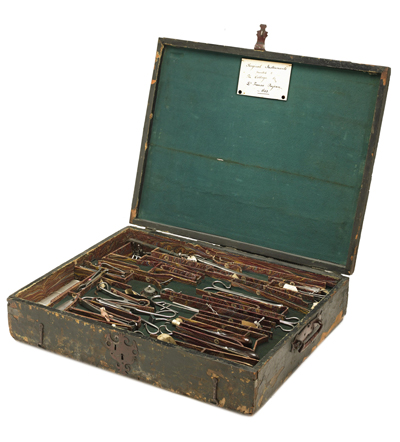The Royal College of Physicians are reflecting on their new home and how they have come to occupy a building a senior member regards as resembling a battleship and a neighbour thinks looks like a sausage factory.
But then, the year just gone by has been a pretty remarkable one…
In ’64 Harold Wilson and Labour won a general election for the first time in 13 years ousting a Tory party laid low since the Profumo affair and heralding an end to the age of deference. That Was The Week That Was may have gone to America, but the satire boom is in full swing, just like, so they say, London itself.
Private Eye is on the shelves alongside Lady Chatterley’s Lover, Top of the Pops is on the television, The Beatles are at number one, seemingly all the time, a barefoot Sandie Shaw and made up Dusty Springfield are new kinds of female singers. Many Quant and the mini skirt have arrived.
Bond is back in the gloriously overboard Goldfinger, its theme tune belted out by arguably Britain’s first home-grown black superstar.
A cooler gentler form of jazz still plays for hip cats on London’s club scene, while ‘theatre clubs’ like the New Watergate are redefining what constitutes obscene on the stage and flouting centuries-old censorship laws in the process. From France a New Wave in cinema flows across the Channel blown on the winds of Left Bank cool and existential philosophy.
In this era of technological white heat, economic success and social reform a mood of optimism, sometimes anarchic, often tempered by harsh reality, but defiant all the same, reigns supreme.
It is a time of unprecedented levels of housebuilding: council estates replace slums and bomb damage, New Towns for old. Danish design and the cheerful chic of the nearly-but-not-forgotten Festival of Britain are filtering through to the buying habits of enthusiastic young consumers eager to furnish these first homes. Terrance Conran opens his habitat store on the Fulham Road.
A generation of uncompromisingly drawn Universities constructed on the edge of towns and cities is springing up in concrete campuses. Arts centres and civic projects taking their lead from London’s South Bank bring culture, so the hope goes, to the masses up and down the land. New schools, soon all to be comprehensives, open at a rate not seen since the reforming zeal of the Victorians.
Gleaming hospitals, palaces of hygiene and healing for a National Health Service not yet 20 years old, are commissioned with pride and commitment.
And everywhere, in house and home, school and art centre, university and shopping precinct, habitat store and hospital one style dominates.
That style, the style of the ’60s, is modernism.
Be it international, Scandinavian, Bauhaus, Brutalist, sleek or neo-deco, modernism is the look.
Modernism as much as the miniskirt, the Vidal Sassoon bob, or The Beatles mop came to define a decade and more of post war Britain.
So when the Physicians reflect, then and now, on how a body as august and ancient as theirs ended up with such a remarkable, unflinchingly modernist home, it is because they wanted to move, and to be seen to be moving, in time with the modern world.
Because Sir Robert Platt, the president of the RCP who helped select the up and coming Denys Lasdun as their architect, saw an opportunity to shift the organisation and its members, physically and psychologically, out of the space they previously occupied at the heart of clubland in Pall Mall and into the new world of optimism, even egalitarianism, which beckoned them at Regent’s Park.
Their great fortune and ours is that they did chose Lasdun, an architect on the very top of his form, to execute this plan, and that the Physicians had the courage and the deep pockets to provide for a generous, beautifully appointed, proportioned and realised building that has become an absolute classic of its kind.
More sublime than sausage factory.
If your intrigue has been enticed into exploring this masterpiece building and its collections, and reliving something of the spirit of the ’60s on Thursday 29 January the Royal College of Physicians will be staging
Lasdun Late : Modernism at the Medical Museum…
“Banish the cold and midwinter blues with a dose of mid-century cool. An exclusive late view of acclaimed retrospective “The anatomy of a building” showcasing the work of modernist uber architect Denys Lasdun in his 60s design classic the Royal College of Physicians.
“Live lounge core marimba jazz, Bond themes, black berets, retro board games, Eames chairs, a style council with the Director of the 20th Century Society and a free drink for all ensure the evening goes with a swing.”
We’ll be there with our friends from Meetup and http://londonexhibitions.co.uk/ and would love it if you could join us.
Tickets are just £10 (including a free drink) and are, unsurprisingly, selling out like chicken bricks and lava lamps from that first habitat branch.
For more details of the evening, what else there’s to see at the RCP and to reserve your place visit the RCP website
The exhibition The anatomy of a building : Denys Lasdun and the Royal College of Physicians runs until 13 February click here for more information

Our half-day study tour Modernism Optimism Medicine Architecture, looking at London’s happy masterpieces of the post-war period from the Royal Festival Hall to the RCP is a must for anyone with a passion for the period and can be booked for private groups at any time. Find all the details here.
























